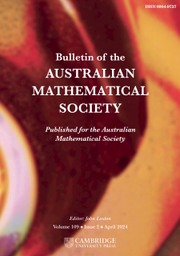No CrossRef data available.
Article contents
ON MAXIMAL SUBSETS OF PAIRWISE NONCOMMUTING ELEMENTS IN FINITE  $p$-GROUPS
$p$-GROUPS
Published online by Cambridge University Press: 20 August 2015
Abstract
A subset  $X$ of a finite group
$X$ of a finite group  $G$ is a set of pairwise noncommuting elements if
$G$ is a set of pairwise noncommuting elements if  $xy\neq yx$ for all
$xy\neq yx$ for all  $x\neq y\in X$. If
$x\neq y\in X$. If  $|X|\geq |Y|$ for any other subset
$|X|\geq |Y|$ for any other subset  $Y$ of pairwise noncommuting elements, then
$Y$ of pairwise noncommuting elements, then  $X$ is called a maximal subset of pairwise noncommuting elements and the size of such a set is denoted by
$X$ is called a maximal subset of pairwise noncommuting elements and the size of such a set is denoted by  ${\it\omega}(G)$. In a recent article by Azad et al. [‘Maximal subsets of pairwise noncommuting elements of some finite
${\it\omega}(G)$. In a recent article by Azad et al. [‘Maximal subsets of pairwise noncommuting elements of some finite  $p$-groups’, Bull. Iran. Math. Soc.39(1) (2013), 187–192], the value of
$p$-groups’, Bull. Iran. Math. Soc.39(1) (2013), 187–192], the value of  ${\it\omega}(G)$ is computed for certain
${\it\omega}(G)$ is computed for certain  $p$-groups
$p$-groups  $G$. In the present paper, our aim is to generalise these results and find
$G$. In the present paper, our aim is to generalise these results and find  ${\it\omega}(G)$ for some more
${\it\omega}(G)$ for some more  $p$-groups of interest.
$p$-groups of interest.
MSC classification
Information
- Type
- Research Article
- Information
- Bulletin of the Australian Mathematical Society , Volume 92 , Issue 3 , December 2015 , pp. 380 - 389
- Copyright
- © 2015 Australian Mathematical Publishing Association Inc.

